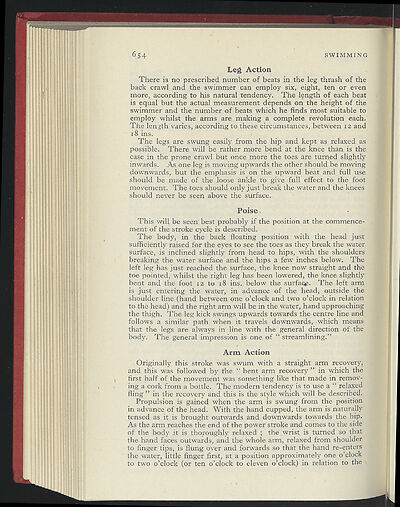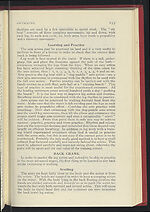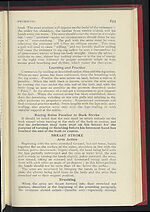1952-53
(686)
Download files
Complete book:
Individual page:
Thumbnail gallery: Grid view | List view

654.
SWIMMING
Leg Action
There is no prescribed number of beats in the leg thrash of the
back crawl and the swimmer can employ six, eight, ten or even
more, according to his natural tendency. The length of each beat
is equal but the actual measurement depends
on
the height of the
swimmer and the number of beats which he finds most suitable to
employ whilst the arms are , making a complete revolution each.
The length varies, according to these circumstances, between iz and
18 ins.
The legs are swung easily from the hip and kept as relaxed as
possible. There will be rather more bend at the knee than is the
case in the prone crawl but once more the toes are turned slightly
inwards. As one leg is moving upwards the other should be moving
downwards, but the emphasis- is on the upward beat and full use
should be made of the loose ankle to give full effect to the foot
movement. The toes should only just break the water and the knees
should never be seen above the surface.
Poise
This will be seen best probably if the position at the commence-
ment of the stroke cycle is described.
The body, in the back floating position with the head just
sufficiently raised for the eyes to see the toes as they break the water
surface, is inclined slightly from head to hips, with the shoulders
breaking the water surface and the hips a few inches below. The
left leg has just reached the surface, the knee now straight and the
toe pointed, whilst the right leg has been lowered, the knee slightly
bent and the foot i z to 18 ins. below the surface. The left arm
is just entering the water, in advance of the head, outside the
shoulder line (hand between one o'clock and two o'clock in relation
to the head) and the right arm will be in the water, hand approaching
the thigh. The leg kick swings upwards towards the centre line and
follows a similar path when it travels downwards, -which means
that the legs are always in line with the general direction of the
body. The general impression is one of " streamlining."
Arm Action
Originally this stroke was swum with a straight arm recovery,
and this was followed by the " bent arm recovery " in which the
first half of the movement was something like that made in remov-
ing a cork from a bottle. The modern tendency is to use a " relaxed
fling " in the recovery and this is the style which will be described.
Propulsion is gained when the arm is swung from the position
in advance of the head. With the hand cupped, the arm is naturally
tensed as it is brought outwards and downwards towards the hip.
As the arm reaches the end of the power stroke and comes to the side
of the body it is thoroughly relaxed ; the wrist is turned so that
the hand faces outwards, and the whole arm, relaxed from shoulder
to finger tips, is flung over and forwards so that the hand re-enters
the water, little finger first, at a position approximately one o'clock
to two o'clock (or ten o'clock to eleven o'clock) in relation to the
SWIMMING
Leg Action
There is no prescribed number of beats in the leg thrash of the
back crawl and the swimmer can employ six, eight, ten or even
more, according to his natural tendency. The length of each beat
is equal but the actual measurement depends
on
the height of the
swimmer and the number of beats which he finds most suitable to
employ whilst the arms are , making a complete revolution each.
The length varies, according to these circumstances, between iz and
18 ins.
The legs are swung easily from the hip and kept as relaxed as
possible. There will be rather more bend at the knee than is the
case in the prone crawl but once more the toes are turned slightly
inwards. As one leg is moving upwards the other should be moving
downwards, but the emphasis- is on the upward beat and full use
should be made of the loose ankle to give full effect to the foot
movement. The toes should only just break the water and the knees
should never be seen above the surface.
Poise
This will be seen best probably if the position at the commence-
ment of the stroke cycle is described.
The body, in the back floating position with the head just
sufficiently raised for the eyes to see the toes as they break the water
surface, is inclined slightly from head to hips, with the shoulders
breaking the water surface and the hips a few inches below. The
left leg has just reached the surface, the knee now straight and the
toe pointed, whilst the right leg has been lowered, the knee slightly
bent and the foot i z to 18 ins. below the surface. The left arm
is just entering the water, in advance of the head, outside the
shoulder line (hand between one o'clock and two o'clock in relation
to the head) and the right arm will be in the water, hand approaching
the thigh. The leg kick swings upwards towards the centre line and
follows a similar path when it travels downwards, -which means
that the legs are always in line with the general direction of the
body. The general impression is one of " streamlining."
Arm Action
Originally this stroke was swum with a straight arm recovery,
and this was followed by the " bent arm recovery " in which the
first half of the movement was something like that made in remov-
ing a cork from a bottle. The modern tendency is to use a " relaxed
fling " in the recovery and this is the style which will be described.
Propulsion is gained when the arm is swung from the position
in advance of the head. With the hand cupped, the arm is naturally
tensed as it is brought outwards and downwards towards the hip.
As the arm reaches the end of the power stroke and comes to the side
of the body it is thoroughly relaxed ; the wrist is turned so that
the hand faces outwards, and the whole arm, relaxed from shoulder
to finger tips, is flung over and forwards so that the hand re-enters
the water, little finger first, at a position approximately one o'clock
to two o'clock (or ten o'clock to eleven o'clock) in relation to the
Set display mode to:
![]() Universal Viewer |
Universal Viewer | ![]() Mirador |
Large image | Transcription
Mirador |
Large image | Transcription
| Games and sports in the army > 1952-53 > (686) |
|---|
| Permanent URL | https://digital.nls.uk/248826426 |
|---|
| Description | 'Games and Sports in the Army' was an annual publication produced by the British War Office between the 1930s and 1960s. This included the Second World War. It outlines the rules and regulations for games and sports played by members of the armed forces. It features names and photographs of team members, and examples of contemporary advertising. |
|---|---|
| Shelfmark | GWB.52 |

